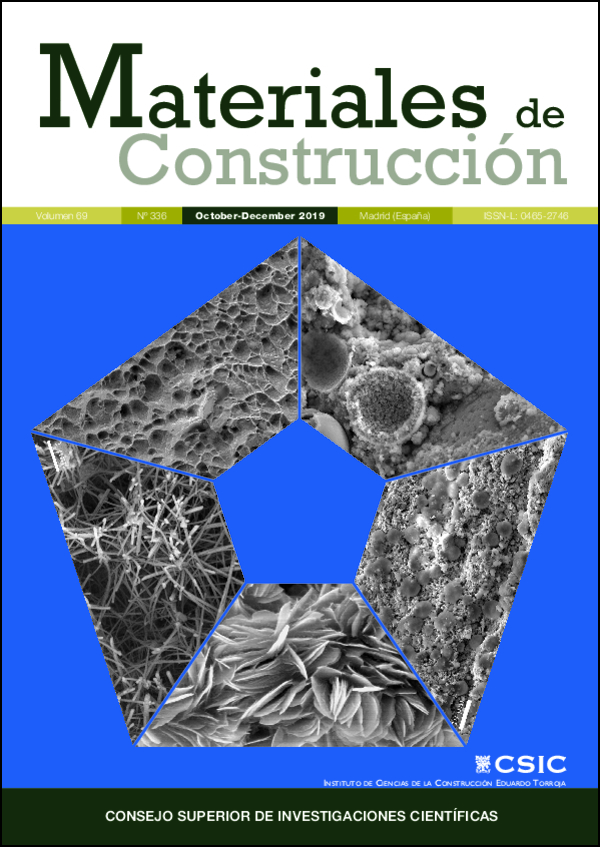Self-activation of slag-cements with glass waste powder
DOI:
https://doi.org/10.3989/mc.2019.13618Keywords:
Blended cement, Slag, Glass, Alkaline activation, Infrared spectroscopyAbstract
The aim of this study is to evaluate the behavior of glass powder waste as alkaline activator of slag when both are used in blended cement. The slag blended cement was prepared with 70% slag, and then the slag was replaced with 10-20% glass powder by mass. The self-activation concept is here introduced. Ground glass releases alkalis through dissolution in a slow and sustained way over time. This would activate slag. Ground glass improves fluidity of mortars and the compressive strength overcomes dilution and increases with age due to the combined pozzolanic action of slag and glass. The proposed blended cement has better mechanical properties than slag-cement. The proposed blended cement has better mechanical properties than slag-cement and due to less use of slag, it becomes more sustainable and it contributes to waste management.
Downloads
References
Li, C.; Sun, H.; Li, L. (2010) A review: The comparison between alkali-activated slag (Si+Ca) and metakaolin (Si+Al) cements. Cem. Concr. Res. 40, 1341-1349. https://doi.org/10.1016/j.cemconres.2010.03.020
Menendez, G.; Bonavetti, V.L., Irassar, E.F. (2003) Strength development of ternary blended cement with limestone filler and blast-furnace slag, Cem. Concr. Compos. 25 [1] 57-63. https://doi.org/10.1016/S0958-9465(01)00056-7
Castellano, C.C.; Bonavetti, V.L.; Donza, H.A.; Irassar, E.F. (2016) The effect of w/b and temperature on the hydration and strength of blastfurnace slag cements, Constr. Build. Mater. 111, 679-688. https://doi.org/10.1016/j.conbuildmat.2015.11.001
García-Lodeiro, I.; Maltseva, O.; Palomo, A.; Fernández- Jiménez, A. (2012) Hybrid alkaline cements. Part I: fundamentals, Rom. J. Mater. 42 [4] 330-335.
Palomo, A.; Maltseva, O.; Garcia Lodeiro, I.; Fernandez Jimenez, A. (2013) Hybrid alkaline cements. Part II: the clinker factor, Rom. J. Mater. 43 [1] 74-80.
Angulo-Ramírez, D.E.; Mejía de Gutiérrez, R.; F. Puertas, (2017) Alkali-activated Portland blast-furnace slag cement: Mechanical properties and hydration, Constr. Build. Mater. 140, 119-128. https://doi.org/10.1016/j.conbuildmat.2017.02.092
Palomo Tomás, V.; Reciclar vidrio es ahorrar combustible. Available online: http://www.justoysustentable.org/2012/04/reciclar-vidrio-es-ahorrar-combustible.html. Acceded 24/06/2016.
Shi, C.; Zheng, K.; (2007) A review on the use of waste glasses in the production of cement and concrete, Resour. Conserv. Recyc. 52 [2] 234-247. https://doi.org/10.1016/j.resconrec.2007.01.013
Trezza, M.A; Rahhal, V.F. (2018) Behavior of the ground glass waste in blending cements: Comparative study with microsilice. Materia 23 [1]. https://doi.org/10.1590/s1517-707620170001.0311
Federico, L.M.; Chidiac, S.E. (2007) Waste glass as a supplementary cementitious material in concrete - Critical review of treatment methods, Cem. Concr. Compos. 31, 306-310.
Zhang, S.; Keulen, A.; Arbi, K.; Ye Zhang, G. (2017) Waste glass as partial mineral precursor in alkali-activated slag/ fly ash system. Cem. Concr. Res. 102, 29-40. https://doi.org/10.1016/j.cemconres.2017.08.012
Marchetti, G.; Rahhal, V.F.; Irassar, E.F. (2017) Influence of packing density and water film thickness on earlyage properties of cement pastes with limestone filler and metakaolin. Mat. Struct. 50 [2] 111. https://doi.org/10.1617/s11527-016-0979-1
Mostafá, N.Y.; El-Hernaly, S.A.S.; Al-Wakeel, E.I.; El-Korashy, S.A.; Brown, P.W. (2001) Characterization and evaluation of the hydraulic activity of water-cooled slag and air- cooled slag. Cem. Concr. Res. 31[6], 899-904. https://doi.org/10.1016/S0008-8846(01)00497-5
Torres-Carrasco, M.; Rodriguez-Puertas, C.; Alonso, M.M. (2015) Alkali activated slag cements using waste glass as alternative activators. Rheological behaviour. Bol. Soc. Esp. Ceram. Vidr. 54, 45-57. https://doi.org/10.1016/j.bsecv.2015.03.004
Bensted, J.; Varma, S.P. (1974) Some applications of infrared and Raman spectroscopy in cement chemistry. Part I- Examination of dicalcium silicate. Cement Technology, 256-261.
ASTM C1437-15, Standard Test Method for Flow of Hydraulic Cement Mortar
EN 196-5: Cements Test Methods: Pozzolanic test for Pozzolanic cements (in Spanish).
Shi, C.; Day, R. (1995). A calorimetric study of early hydration of alkali-slag cement, Cem. Concr. Res. 25 [6] 1333-1346. https://doi.org/10.1016/0008-8846(95)00126-W
Bakharev, T.; Sanjayan, J.; Cheng, Y-B. (1999) Álkali activation of Australian slag cements, Cem. Concr. Res. 29, 113-120. https://doi.org/10.1016/S0008-8846(98)00170-7
Mollah, M.Y.A.; Yu, W.; Schennach, R.; Cocke, D. (2000) A Fourier transforms infrared spectroscopic investigation of the early hydration of Portland cement and the influence of sodium lignosulfonate. Cem.Concr.Res. 30, 267-273. https://doi.org/10.1016/S0008-8846(99)00243-4
Puertas, F.; Torres-Carrasco, M. (2014) Use of glass waste as an activator in the preparation of alkali-activated slag. Mechanical strength and paste characterization. Cem.Concr.Res. 57, 95-104. https://doi.org/10.1016/j.cemconres.2013.12.005
Farcas, F.; Touzé, P. (2001) Infrared Fourier Transform (IRFT) spectrometry. A valuable technique for characterizing cement. Bulletin des Laboratories des Ponts et Chaussées. 230 [4350] 77-88.
Bensted, J.; Varma, S.P. (1977), Infrared and Raman spectroscopy in cement chemistry-miscellaneous applications. World Cement Technology 8 [1] 16, 18-20.
Mindess, S.; Young, J.F. (1981) Concrete, Cap.4. Prentice- Hall, New Jersey, 1981.
Published
How to Cite
Issue
Section
License
Copyright (c) 2019 Consejo Superior de Investigaciones Científicas (CSIC)

This work is licensed under a Creative Commons Attribution 4.0 International License.
© CSIC. Manuscripts published in both the print and online versions of this journal are the property of the Consejo Superior de Investigaciones Científicas, and quoting this source is a requirement for any partial or full reproduction.
All contents of this electronic edition, except where otherwise noted, are distributed under a Creative Commons Attribution 4.0 International (CC BY 4.0) licence. You may read the basic information and the legal text of the licence. The indication of the CC BY 4.0 licence must be expressly stated in this way when necessary.
Self-archiving in repositories, personal webpages or similar, of any version other than the final version of the work produced by the publisher, is not allowed.
















